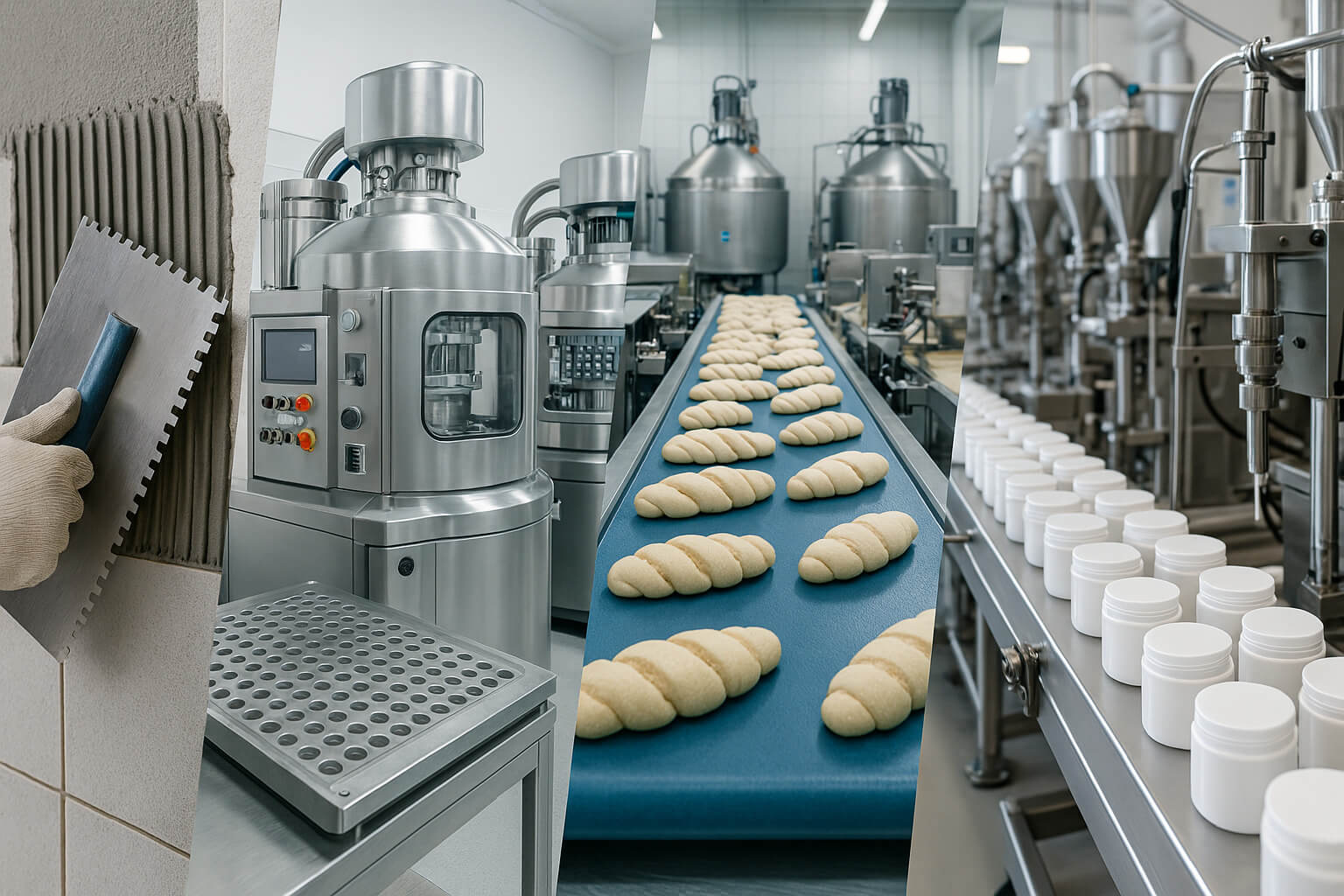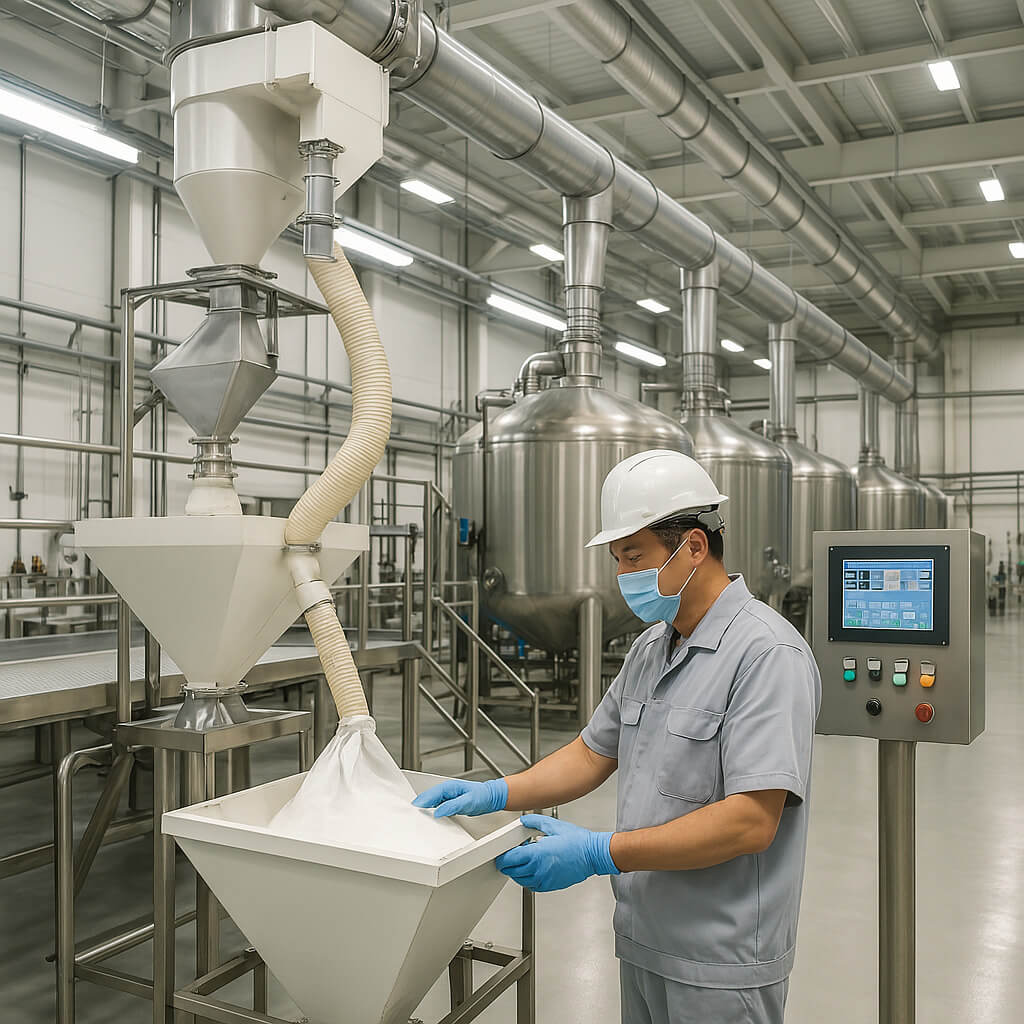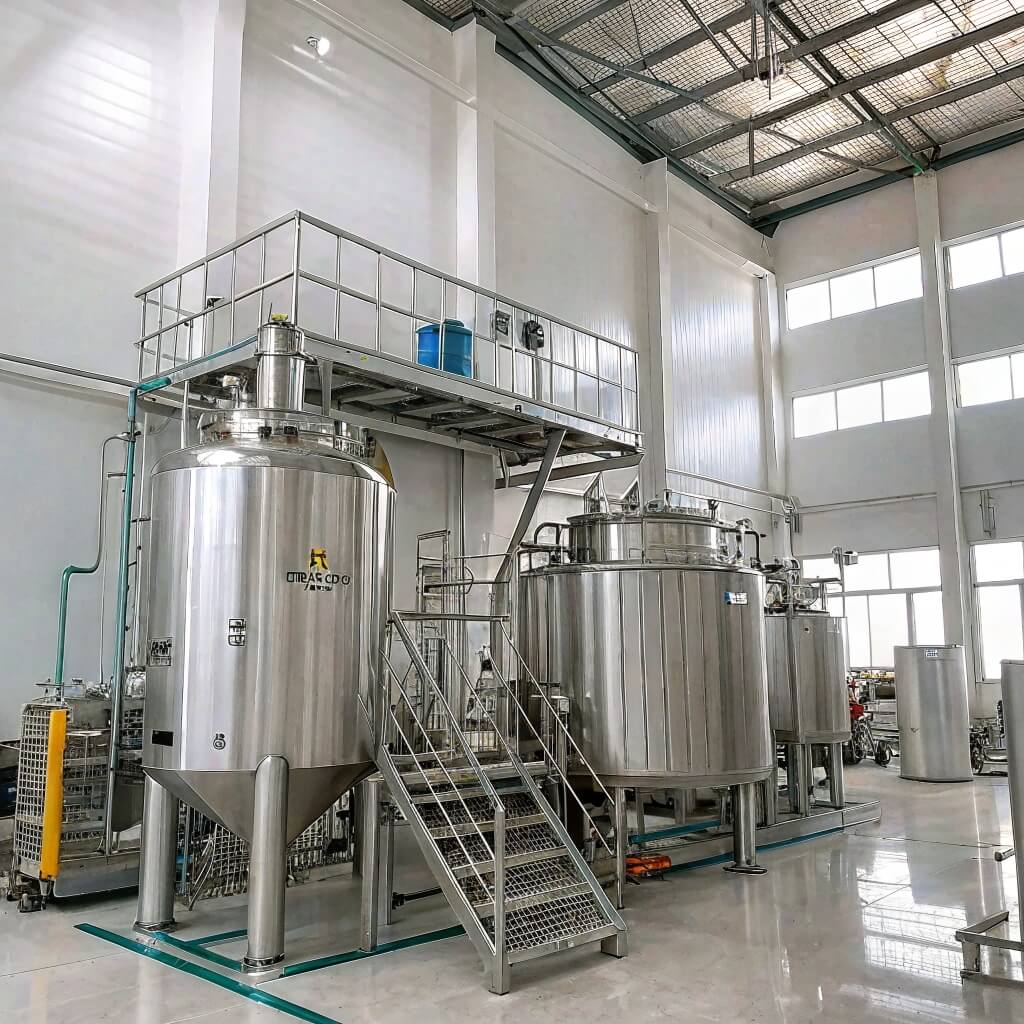Many businesses struggle to find the right HPMC grade for their application, wasting money on unsuitable products and facing formula failures.
HPMC from manufacturers serves diverse industries including construction (mortars, adhesives), pharmaceuticals (tablets, controlled release), food (bakery, plant-based), personal care, and industrial applications requiring thickening, binding, or film-forming.

A collage showing multiple industries using HPMC including construction (tile adhesive application), pharmaceuticals (tablet manufacturing), food production, and personal care products.
Let's examine how various sectors use this versatile polymer and what makes each application unique.
What is the overview of our topic?
Sourcing the right HPMC can be confusing with so many grades, specifications, and conflicting supplier claims.
HPMC (Hydroxypropyl Methylcellulose) is a modified cellulose polymer serving as a binding agent, thickener, film former, water retention aid, and stabilizer across construction, pharmaceutical, food, personal care, and industrial applications, with each industry requiring specific grades for their unique needs.
HPMC stands out for its versatility across multiple sectors. As manufacturers with extensive experience producing HPMC, we've gained unique insight into how this polymer meets diverse requirements.
At its foundation, HPMC is a cellulose ether created by modifying natural cellulose. This modification introduces methyl and hydroxypropyl groups to the cellulose chain, resulting in valuable properties:
• Water solubility while maintaining film-forming capabilities
• Controlled viscosity based on molecular weight
• Surface activity and binding strength
• Thermal gelation at specific temperatures
• pH stability across a wide range (2-12)
These properties make HPMC useful across seemingly unrelated industries, though each application requires specific adjustments to optimize performance.
The manufacturing process involves treating cellulose with sodium hydroxide, which then reacts with methyl chloride and propylene oxide in varying ratios. By controlling reaction conditions, manufacturers produce HPMC with different substitution patterns directly influencing final performance.
| Application Sector | Доля рынка | Основные требования |
|---|---|---|
| Строительство | ~65% | Water retention, workability |
| Фармацевтика | ~20% | Purity, controlled dissolution |
| Еда | ~10% | Neutral taste, viscosity |
| Other Industries | ~5% | Application-specific properties |
The market distribution has evolved over time, with pharmaceutical applications growing more rapidly due to expanding use in controlled-release formulations.
How does the construction industry rely on HPMC manufacturers?
Builders face project delays and quality issues when their mortars and adhesives lack the right HPMC grade for proper open time and workability.
Construction relies on HPMC for water retention in cement-based products, improved workability in mortars, enhanced adhesion in tile adhesives, reduced sag in vertical applications, and extended open time for better installation flexibility.
The construction sector represents the largest HPMC application area. As manufacturers supplying construction clients globally, we've developed deep understanding of how HPMC functions in building materials.
The primary function of HPMC in construction involves water retention. Cement-based products require water for hydration, but uncontrolled water loss leads to incomplete curing and reduced strength. HPMC creates a protective colloid that holds water within the mixture, ensuring proper cement hydration even under challenging conditions.
Different applications require specific water retention profiles. Thin-set tile adhesives need stronger water retention than thicker renders. We produce HPMC grades with water retention values from 95% to 99% to match these varied requirements.
HPMC also improves workability by lubricating aggregate particles and creating a more cohesive mixture. This allows easier application, reduced effort, and smoother finished surfaces.
One of the most demanding construction applications involves tile adhesives. These products require:
• Extended open time for proper tile positioning
• Strong adhesion to both substrate and tile
• Sufficient sag resistance for wall applications
The European standard EN 12004 defines specific performance requirements for tile adhesives. Meeting these standards requires precisely formulated HPMC.
We produce specialized construction grades with optimized dissolution rates providing immediate viscosity development while maintaining workability over the required open time.
Pre-mixed dry mortar systems depend on high-quality HPMC for shelf life while providing immediate performance when mixed with water. For these products, HPMC must provide rapid dissolution, consistent viscosity development, and compatibility with other admixtures.
| Применение в строительстве | Critical HPMC Properties | Typical Viscosity |
|---|---|---|
| Клеи для плитки | Open time, sag resistance | 15,000-50,000 mPa·s |
| Renders/Plasters | Workability, water retention | 20,000-70,000 mPa·s |
| Self-leveling Compounds | Flow properties | 15,000-40,000 mPa·s |
Why is pharmaceutical grade HPMC essential in the medical field?
Pharmaceutical formulators risk regulatory rejection and inconsistent drug performance when using industrial HPMC grades not manufactured for medical applications.
Pharmaceutical grade HPMC is essential in medicine as a tablet binding agent and controlled-release matrix, capsule shell material, ophthalmic solution component, liquid formulation stabilizer, and meets stringent regulatory requirements for purity and consistency.
The pharmaceutical industry represents the second-largest HPMC application area, with requirements differing dramatically from construction applications. As manufacturers supplying USP/EP-grade HPMC to pharmaceutical companies globally, we understand the critical parameters and regulatory requirements for these grades.
One of the most valuable pharmaceutical applications involves controlled release drug delivery systems. When properly formulated, HPMC creates a hydrophilic matrix that controls drug release rates through swelling, diffusion, and erosion mechanisms.
This technology allows pharmaceutical companies to develop once-daily dosing that maintains therapeutic drug levels while reducing side effects. The USP recognizes specific HPMC types (2208, 2906, and 2910) based on substitution pattern, directly influencing their behavior in controlled release applications.
Our pharmaceutical-grade HPMC undergoes additional purification steps and more extensive testing than construction grades. We maintain Drug Master Files with regulatory authorities to support our customers' submissions.
Beyond controlled release, HPMC serves as an effective binding agent in direct compression tablet formulations. Its binding strength helps maintain tablet integrity without the moisture sensitivity of some natural binders. Low-viscosity grades (3-15 mPa·s) typically perform best in this application.
HPMC also excels as a film coating polymer, forming transparent, flexible films that protect tablets from moisture while masking taste or odor.
For pharmaceutical applications, manufacturers require HPMC with:
• Extremely low microbial counts
• Minimal heavy metal content
• Absent or strictly limited organic volatiles
• Batch-to-batch consistency in all parameters
We maintain dedicated production lines for pharmaceutical grades to prevent cross-contamination and implement extensive testing to verify these critical quality attributes.
A growing application involves vegetarian capsule shells made from HPMC (hypromellose capsules). These provide an alternative to gelatin for vegetarian preferences and applications where gelatin's moisture sensitivity causes problems.
HPMC capsules offer advantages including stability across wider humidity ranges, compatibility with more fill materials, absence of cross-linking issues, and vegetarian acceptability.
What roles do HPMC suppliers play in food, cosmetics, and personal care?
Food and personal care formulators struggle to find food-grade HPMC with the right combination of viscosity, temperature response, and sensory neutrality for their recipes.
HPMC suppliers support food and personal care industries by providing thickeners for bakery and plant-based foods, emulsion stabilizers for sauces, film-formers for cosmetics and hair products, controlled-viscosity agents for skincare, and ensuring all products meet food safety standards.
While construction and pharmaceuticals represent the largest HPMC markets, food, cosmetics, and personal care applications utilize significant volumes of specialized grades. These applications share requirements for exceptional purity and sensory neutrality but differ in their specific functional needs.
In food applications, HPMC serves multiple functions depending on the product category. As manufacturers of food-grade HPMC complying with E464 specifications, we've supported food producers in developing innovative formulations.
HPMC improves dough handling, increases volume in baked goods, and enhances moisture retention for extended freshness. In gluten-free bakery products, it provides the structural properties normally supplied by gluten, allowing for improved texture and volume.
For bakery applications, HPMC must provide thermal gelation at baking temperatures, neutral taste and odor, and compatibility with other ingredients.
The growing plant-based foods market relies heavily on HPMC for texture and stability. In meat alternatives, HPMC creates the binding effect that mimics animal proteins. In plant-based dairy alternatives, it serves as a stabilizer preventing separation while contributing minimal flavor.
In personal care products, HPMC creates smooth, non-tacky films that enhance product feel while delivering active ingredients to the skin. It provides controlled viscosity in serums and gels without the stickiness of some natural gums.
In hair care products, HPMC serves as a film-former and conditioning agent, providing light hold without stiffness. In shampoos and conditioners, it adds body and improves wet combing properties.
| Приложение | Функция | Critical Properties |
|---|---|---|
| Bakery | Structure, moisture | Thermal gelation, neutral taste |
| Plant-Based Foods | Binding, texture | Gelation profile, stability |
| Skincare | Film formation | Sensory profile, clarity |
| Hair Care | Conditioning | Film properties, compatibility |
Food and cosmetic applications face strict regulatory requirements. Our food-grade HPMC production follows Good Manufacturing Practices specific to food ingredients, with additional testing for potential contaminants beyond standard industrial grades.
How is industrial grade HPMC used in specialized manufacturing?
Industrial product engineers often try generic thickeners only to find they break down under processing conditions or fail to deliver consistent results.
Industrial grade HPMC serves specialized manufacturing as a ceramic extrusion aid improving green strength, an adhesive component in wallpaper pastes, a rheology modifier in paints, a performance additive in building products, and a processing aid in paper manufacturing.
Beyond major application areas, HPMC finds use in various specialized industrial applications. As manufacturers supplying diverse industrial sectors, we've developed specific grades for these specialized uses that differ from standard types.
The ceramic industry utilizes HPMC as a processing aid in critical applications. During extrusion, HPMC provides plasticity and lubrication while contributing to green strength—the strength of unfired ceramic parts. This reduces breakage during handling before firing.
For ceramic applications, HPMC must provide consistent rheological properties, burnout characteristics leaving minimal residue, and sufficient binding strength at low addition levels.
In adhesive formulations, HPMC serves as a thickener, water retention agent, and sometimes primary binder. Common applications include wallpaper adhesives, labeling pastes, and temporary bonding agents.
HPMC contributes several properties to adhesive systems:
• Controlled open time through water retention
• Adjustable viscosity for application methods
• Good substrate wetting and penetration
• Clean machinability in high-speed applications
The adhesives industry continues evolving toward water-based formulations for environmental reasons, increasing demand for effective water-based rheology modifiers like HPMC.
Water-based paints and coatings use HPMC as a thickener and stabilizer providing improved flow, spatter resistance during application, pigment suspension during storage, and enhanced working properties.
What should buyers consider when sourcing HPMC from manufacturers?
Many procurement teams waste money on either overspecified premium grades or underperforming economy options that don't match their actual application needs.
When sourcing HPMC, buyers should consider application-specific grade selection rather than generic types, viscosity and substitution degree matched to performance needs, appropriate quality systems, technical support capabilities, and total cost analysis beyond basic price comparison.
The diverse applications of HPMC across multiple industries make proper sourcing decisions complex. As manufacturers serving clients across all major application sectors, we've developed a structured approach to help buyers find the most appropriate HPMC for their needs.
The first critical sourcing consideration involves matching HPMC specifications to your specific application requirements. Generic descriptions like "construction grade" encompass wide specification ranges that may not optimize performance in your particular use case.
Effective grade selection requires understanding:
• The primary functional role of HPMC in your formulation
• Critical parameters that influence that functionality
• Secondary benefits needed from the HPMC
• Processing conditions that may affect performance
For construction applications, water retention and workability enhancement take priority. Pharmaceutical applications prioritize dissolution profile and regulatory documentation. Food applications balance functional properties with sensory neutrality.
We recommend developing a detailed specification profile based on your application needs rather than requesting "equivalent" products from different suppliers. This ensures you select HPMC that optimizes performance rather than merely meeting basic definitions.
The appropriate quality system depends on your application and regulatory environment. Construction applications typically require ISO 9001 certification. Pharmaceutical applications demand GMP compliance and extensive documentation. Food applications require food safety certifications.
When sourcing HPMC, align the manufacturer's quality system with your specific needs rather than seeking unnecessary certifications that add cost without value or accepting insufficient quality controls that create risk.
Часто задаваемые вопросы
Каковы области применения HPMC?
HPMC applications span multiple industries. In construction, it serves as a water retention agent in mortars, tile adhesives, and plasters. Pharmaceutical uses include controlled-release matrices for tablets, capsule shells, and film coatings. Food applications utilize HPMC as a thickener and stabilizer in bakery products and plant-based foods. Personal care products incorporate it as a film-former and thickener. Industrial applications include ceramic processing aids, adhesives, and paint rheology modifiers.
What is HPMC in pharmaceutical industry?
In pharmaceuticals, HPMC (hypromellose) functions as a tablet binder, controlled-release matrix former, film coating polymer, and vegetarian capsule shell material. It's classified by USP codes like 2208 or 2910 indicating substitution patterns. HPMC provides consistent drug release profiles through its hydrophilic matrix properties, enabling once-daily dosing formats. Pharmaceutical-grade HPMC must meet stringent purity requirements with limited heavy metals, residual solvents, and microbial content.
Кто является производителем ГПМЦ?
HPMC is manufactured by multiple companies globally. Major producers include Morton, Hopetide, and Mejoyo in China, Dow Chemical and Ashland in North America, and Shin-Etsu in Japan. Each manufacturer offers grades optimized for different applications. Morton produces 30,000 tons annually across all major application categories, with specialized production lines for pharmaceutical and food grades meeting international standards including USP, EP, and food regulations.
Для чего используется ГПМЦ в строительстве?
In construction, HPMC primarily functions as a water retention agent preventing premature water loss from cement-based materials, ensuring proper hydration. It improves workability in mortars and plasters, making application easier. HPMC enhances adhesion in tile adhesives, extends open time for better installation, and reduces sag in vertical applications. The typical addition rate ranges from 0.1-0.5% depending on the application, with viscosity grades from 15,000-100,000 mPa·s most common.
Заключение
HPMC serves as a versatile polymer with applications spanning construction, pharmaceuticals, food, personal care, and specialized industrial uses. Each industry leverages different aspects of HPMC's properties, from water retention in construction to controlled release in pharmaceuticals to texture modification in foods.
The specific requirements for each application necessitate careful grade selection and quality system alignment. Construction applications prioritize water retention and workability. Pharmaceutical uses demand regulatory compliance and precise performance. Food applications require sensory neutrality alongside functional benefits.
When sourcing HPMC, buyers should consider application-specific performance, appropriate quality systems, and technical support capabilities. Contact Morton today to discuss your HPMC requirements and experience how our expertise can enhance your product performance.




